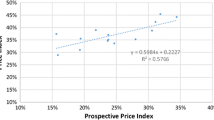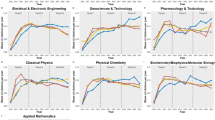Abstract
We provide a view of the literature aging features in the sciences and social sciences, at different aggregation levels, of major fields, subfields, journals and individual papers and from different perspectives. Against to the wide belief that scientific literature may become more rapidly obsolete, we found that, in general, the share of more recent references were distinctly lower in 2014 than that in 1992, which holds for all aggregation levels. As exceptions, the subfields related to Chemistry and the subfield energy and fuels, have shown a clear trend to cite more recent literature than older articles. Particle and nuclear physics and astronomy and astrophysics, the two subfields which strongly rely on e-print archives, have shown a ‘polarization’ tendency of reference distribution. Furthermore, we stress that it is very important to measure the Price Index at the paper level to account for differences between the documents published in the same journals and (sub-)fields.

Data sourced from Thomson Reuters Web of Science Core Collection

Data sourced from Thomson Reuters Web of Science Core Collection

Data sourced from Thomson Reuters Web of Science Core Collection

Data sourced from Thomson Reuters Web of Science Core Collection

Data sourced from Thomson Reuters Web of Science Core Collection

Data sourced from Thomson Reuters Web of Science Core Collection
Similar content being viewed by others
References
Alarran, P., & Ruiz-Castillo, J. (2011). References mode and citations received by scientific articles. Journal of the American Society for Information Science and Technology, 62(1), 40–49.
Egghe, L., Rao, R., & Rousseau, R. (1995). On the influence of production on utilization functions: Obsolescence or increased use? Scientometrics, 34(2), 285–315.
Evans, J. A. (2008). Electronic publication and the narrowing of science and scholarship. Science, 321(5887), 395–399.
Glänzel, W. (2004). Towards a model for diachronous and synchronous citation analyses. Scientometrics, 60(3), 511–522.
Glänzel, W., & Schoepflin, U. (1999). A bibliometric study of reference literature in the sciences and social sciences. Information Processing and Management, 35(1), 31–44.
Glänzel, W., & Schubert, A. (2003). A new classification scheme of science fields and subfields designed for scientometric evaluation purposes. Scientometrics, 56(3), 357–367.
Lariviere, V., Archambault, E., & Gingras, Y. (2008). Long-term variations in the aging of scientific literature: From exponential growth to steady-state science (1900–2004). Journal of the American Society for Information Science and Technology, 59(2), 288–296.
Line, M. B. (1970). The ‘half-life’ of periodical literature: Apparent and real obsolescence. Journal of Documentation, 26(1), 46–54.
Martin-Martin, A., Orduna-Malea, E., Ayllon, J. M., et al. (2016). Back to the past: On the shoulders of an academic search engine giant. Scientometrics, 107(3), 1477–1487.
Merton, R. K. (1968). The Matthew effect in science. Science, 159(3810), 56–63.
Moed, H. F. (1989). Bibliometric measurement of research performance and Price’s theory of differences among the sciences. Scientometrics, 15(5–6), 473–483.
Persson, O., Glänzel, W., & Danell, R. (2004). Inflationary bibliometric values: The role of scientific collaboration and the need for relative indicators in evaluative studies. Scientometrics, 60(3), 421–432.
Price, D. J. D. (1965). Networks of scientific papers. Science, 149(3683), 510–515.
Price, D. J. D. (1970). Citation measures of hard science, soft science, technology, and nonscience. In C. E. Nelson & D. K. Pollock (Eds.), Communication among scientists and engineers (pp. 3–22). Lexington, MA: Heath.
Schoepflin, U., & Glänzel, W. (2001). Two decades of “Scientometrics”. Scientometrics, 50(2), 301–312.
Simkin, M. V., & Roychowdhury, V. P. (2005). Stochastic modeling of citation slips. Scientometrics, 62(3), 367–384.
van Raan, A. F. J. (2000). On growth, ageing, and fractal differentiation of science. Scientometrics, 47(2), 347–362.
Verstak, A., Acharya, A., Suzuki, H., et al. (2014). On the shoulders of giants: The growing impact of older articles. http://arxiv.org/abs/1411.0275. Accessed July 22, 2015.
Zhang, L., Rousseau, R., & Glänzel, W. (2016). Diversity of references as an indicator for interdisciplinarity of journals: Taking similarity between subject fields into account. Journal of the American Society for Information Science and Technology, 67(5), 1257–1265.
Acknowledgements
Lin Zhang acknowledges the National Natural Science Foundation of China Grants 71573085 and 71103064, the Innovation talents of science and technology in HeNan Province (16HASTIT038; 2015GGJS-108) and the research center of information technology & economic and social development in Zhejiang Province. We are grateful for two anonymous reviewers’ insightful comments and valuable advices.
Author information
Authors and Affiliations
Corresponding author
Rights and permissions
About this article
Cite this article
Zhang, L., Glänzel, W. A citation-based cross-disciplinary study on literature aging: part I—the synchronous approach. Scientometrics 111, 1573–1589 (2017). https://doi.org/10.1007/s11192-017-2289-y
Received:
Published:
Issue Date:
DOI: https://doi.org/10.1007/s11192-017-2289-y




